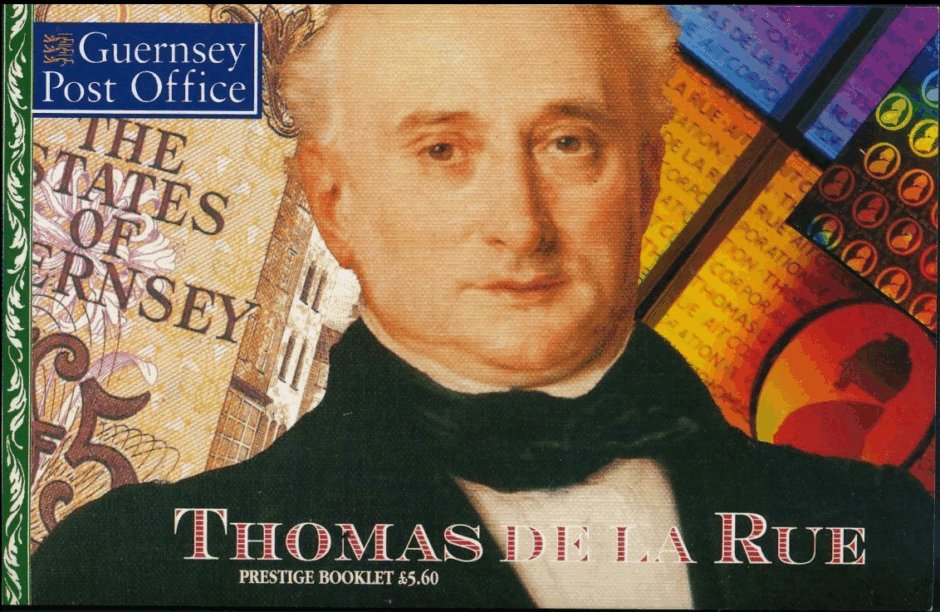
PostBeeld’s Dutch and Belgian stamp blog has some great contributors. Generally they go into far more detail with their articles than the English language blog, with its shorter stories. One of our Dutch authors is Cees Janssen whose superb articles have graced the pages of the Dutch website for many years. This is Part One of a typically lengthy and informative article written by Cees in 2022.

Many stamp collectors know the name “De La Rue” as a printing company that printed stamps for many countries. But who founded this printing company with a French name, and where is it located? The literal translation of “De la Rue” in English is “From the Street,” not an obvious name for a printing company. So where does it come from?

The stamp printing company often printed its name on the bottom edge of the stamps themselves. Take the example above, for example, of a Peruvian airmail stamp issued on November 19, 1962, printed by Thomas de la Rue & Co. Ltd. Here, the printing company’s name is printed in full. But who was Thomas de la Rue?

The cover of a Guernsey prestige booklet published in 1993 features the portrait of Thomas de la Rue, the founder of one of the world’s largest and most important printing companies for securities, banknotes, and stamps. Thomas was born on March 24, 1793, on the island of Guernsey in Le Bourg, a village just south of the island’s current airport. This immediately explains Thomas’s French name, as many villages and towns in the Channel Islands have French names, and many families also bear French names. At that time, French was more widely spoken than English on the islands just off the Normandy coast. The French call the islands “Îles Anglo-Normandes.” The English call them “Channel Islands.”
Thomas was the seventh child of his parents, Rachael Allez and Eleazar de la Rue. At the age of ten, he apprenticed with master printer Joseph Antoine Chevalier in Saint Peter Port, the capital of the island of Guernsey. There, he learned the printing trade and, with his expertise and financial support from Tom Greenslade, published a newspaper called “Le Publiciste.” However, a rift soon developed between the two owners, and Thomas began printing his own newspaper, “Le Miroir Politique,” on February 6, 1813.

On March 21, 1816, he married Jane Warren, and in 1818, Thomas de la Rue and his family moved to London to start a completely new business. Not a printing house, but a factory where straw hats were manufactured, an item that was very fashionable at the time. The business flourished, and the businessman Thomas, along with the British Samuel Cornish and William Rock, established another new company as “printers and book binders.” In 1828, he began operating a bookstore and manufacturing luxury goods using printing presses.

In 1831, De la Rue was granted the right to print playing cards, which was converted into a patent by the British King William IV in 1832. Before that, playing cards were printed with woodcuts in blocks using black ink. The images were then colored by hand. De la Rue was the first company in London to produce playing cards using a completely new typographic process. Demand for playing cards increased from bookstores and pubs, and many clubs were formed with card players as members.

At The Pollet in St. Peter Port, there’s a pub called The Thomas de la Rue. A bust of De la Rue is incorporated into its facade. Due to the enormous demand and desire for decks of cards with a wide variety of back images and themes, he hired Owen Jones as a graphic designer. Over the next twenty years, De la Rue produced 173 different stocks of playing cards, ranging from floral and fruit themes to Chinese motifs. De la Rue thus became known as the “father of the English playing card.” From 1837, his wife and two sons worked in the business. To celebrate the coronation of Queen Victoria, he printed a special edition of The Sun in gold print. The 16p stamp pictured above was the first in a series of five issued on July 27, 1993.

In 1848, his son, Warren de la Rue, invented the envelope folding machine. This machine, depicted on the 28p stamp, could produce 2,700 envelopes per hour. It was one of the main attractions at the Great Exhibition of 1851 at Crystal Palace in London.

Thomas de la Rue began printing revenue stamps in 1853 when he received a contract from the British Board of Inland Revenue to produce gummed stamps and perforate them. This laid the foundation for the later production of many millions of stamps.

The first order for stamp printing was for the four-pence stamp depicted in the examples above. This letterpress-printed stamp was first available on July 31, 1855. Orders from Britain’s many colonies followed.

The stamp for the first day of issue depicts one of the first printing presses used by Thomas de la Rue for printing postage stamps. The 2½p stamp was one of four in the series issued on June 2, 1971.

De la Rue printed stamps for the Cape of Good Hope, including the familiar triangle stamps, Mauritius, Western Australia, Trinidad, Ceylon, Hong Kong, Saint Helena, the Bahamas, Natal, Saint Lucia, and other colonies and dominions.
PART TWO FOLLOWS SHORTLY
![]()
